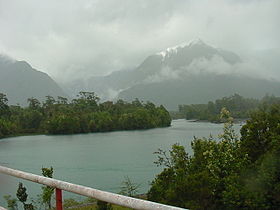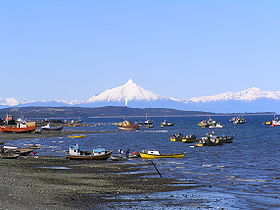- Corcovado National Park (Chile)
-
Corcovado National Park IUCN Category II (National Park)The white dot is the location of Puerto Montt Location Los Lagos Region, Chile Nearest city Chaitén Coordinates 43°25′0″S 72°43′0″W / 43.416667°S 72.716667°WCoordinates: 43°25′0″S 72°43′0″W / 43.416667°S 72.716667°W Area 2,096 km² Established 2005 Governing body Corporación Nacional Forestal Corcovado National Park is an 726,000-acre (2,940 km2) preserved area of Valdivian temperate rainforest, high peaks, alpine lakes, and rivers in Chile's Los Lagos Region. This coastal park borders the same name to the west and includes the iconic volcanoes Corcovado and Yanteles. This preserved area has no public access infrastructure.
History
The park as seen from Quellón
Corcovado National Park represents an innovative joint public/ private conservation effort. While most of the park's area was previously federal land, mostly under the jurisdiction of the Chilean Armed Forces, the 1994 purchase of a key 208,000-acre (840 km2) parcel by the Conservation Land Trust and U.S. philanthropist Peter Buckley sparked the effort to transform this area into a national park. In 2002, through an intermediary, Conservation Land Trust founder Doug Tompkins approached then-president Ricardo Lagos with a proposition: If the private lands around Corcovado were given to the people of Chile, would the government contribute the adjoining federal land and create a new national park? The property was not vital to military readiness, and both President Lagos and General Juan Emilio Cheyre, the nation’s top military officer at the time, endorsed the idea. Corcovado National Park, Chile’s fourth largest, was formally designated by President Lagos in January 2005, largely due to his determination.
Geography
This wilderness park of approximately 726,000 acres (2,940 km2) contains some eighty-two lakes, many ringed with ancient forests where pumas haunt the shadows. The park hosts significant biodiversity, with about 18 mammal species, 64 bird species and 133 flora species. The brackish estuaries where the Corcovado and Tic Toc rivers spill into the Bay of Corcovado are exceptional wildlife habitat. Immense colonies of shorebirds coat the beaches. Penguins scamper about the rocks. Marine mammals, including seals and sea lions, thrive in the bay, which was discovered to be a crucial nursery area for blue whales, Earth’s largest animals. The bay, once the lair of pirates, is now proposed to become Chile’s first marine sanctuary, assuring a continuity of protection for wildlife from ocean bottom to mountain peaks.
References
- (Spanish) Parque Nacional Corcovado
National Parks of Chile Alberto de Agostini | Alerce Andino | Archipiélago de Juan Fernández | Bernardo O'Higgins | Bosque de Fray Jorge | Cabo de Hornos | Chiloé | Conguillío | Corcovado | Hornopirén | Huerquehue | Isla Guamblin | Isla Magdalena | La Campana | Laguna del Laja | Laguna San Rafael | Las Palmas de Cocalán | Lauca | Llanos de Challes | Llullaillaco | Nahuelbuta | Nevado Tres Cruces | Pali Aike | Pan de Azúcar | Puyehue | Queulat | Rapa Nui | Tolhuaca | Torres del Paine | Vicente Pérez Rosales | Villarrica | Volcán Isluga
Categories:- IUCN Category II
- Protected areas of Los Lagos Region
- Protected areas established in 2005
- Geography of Los Lagos Region
- National parks of Chile
Wikimedia Foundation. 2010.



